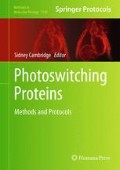Abstract
Manipulation of protein kinase activity is widely used to dissect signaling pathways controlling physiological and pathological processes. Common methods often cannot provide the desired spatial and temporal resolution in control of kinase activity. Regulation of kinase activity by photocaged kinase inhibitors has been successfully used to achieve tight temporal and local control, but inhibitors are limited to inactivation of kinases and often do not provide the desired specificity. Here we report detailed methods for light-mediated activation of kinases in living cells using engineered rapamycin-regulated kinases in conjunction with a photocaged analog of rapamycin.
Access this chapter
Tax calculation will be finalised at checkout
Purchases are for personal use only
References
Bishop AC, Buzko O, Shokat KM (2001) Magic bullets for protein kinases. Trends Cell Biol 11:167–172
Spencer DM, Wandless TJ, Schreiber SL, Crabtree GR (1993) Controlling signal transduction with synthetic ligands. Science 262: 1019–1024
Qiao Y, Molina H, Pandey A, Zhang J, Cole PA (2006) Chemical rescue of a mutant enzyme in living cells. Science 311:1293–1297
Karginov AV, Ding F, Kota P, Dokholyan NV, Hahn KM (2010) Engineered allosteric activation of kinases in living cells. Nat Biotechnol 28:743–747
Karginov AV, Hahn KM (2011) Allosteric activation of kinases: design and application of RapR kinases. Curr Protoc Cell Biol Chapter 14: Unit 14. 13
Dagliyan O, Shirvanyants D, Karginov AV, Ding F, Fee L, Chandrasekaran SN, Freisinger CM, Smolen GA, Huttenlocher A, Hahn KM, Dokholyan NV (2013) Rational design of a ligand-controlled protein conformational switch. Proc Natl Acad Sci U S A 110:6800–6804
Karginov AV, Zou Y, Shirvanyants D, Kota P, Dokholyan NV, Young DD, Hahn KM, Deiters A (2010) Light regulation of protein dimerization and kinase activity in living cells using photocaged rapamycin and engineered FKBP. J Am Chem Soc 133:420–423
Riggsbee CW, Deiters A (2010) Recent advances in the photochemical control of protein function. Trends Biotechnol 28:468–475
Mayer G, Heckel A (2006) Biologically active molecules with a “light switch”. Angew Chem Int Ed Engl 45:4900–4921
Young DD, Deiters A (2007) Photochemical control of biological processes. Org Biomol Chem 5:999–1005
Deiters A (2010) Principles and applications of the photochemical control of cellular processes. Chembiochem 11:47–53
Deiters A (2009) Light activation as a method of regulating and studying gene expression. Curr Opin Chem Biol 13:678–686
Tang X, Dmochowski IJ (2007) Regulating gene expression with light-activated oligonucleotides. Mol Biosyst 3:100–110
Lawrence DS (2005) The preparation and in vivo applications of caged peptides and proteins. Curr Opin Chem Biol 9:570–575
Curley K, Lawrence DS (1999) Light-activated proteins. Curr Opin Chem Biol 3:84–88
Lee HM, Larson DR, Lawrence DS (2009) Illuminating the chemistry of life: design, synthesis, and applications of “caged” and related photoresponsive compounds. ACS Chem Biol 4:409–427
Dorman G, Prestwich GD (2000) Using photolabile ligands in drug discovery and development. Trends Biotechnol 18:64–77
Adams SR, Tsien RY (1993) Controlling cell chemistry with caged compounds. Annu Rev Physiol 55:755–784
Dong Q, Svoboda K, Tiersch TR, Monroe WT (2007) Photobiological effects of UVA and UVB light in zebrafish embryos: evidence for a competent photorepair system. J Photochem Photobiol B 88:137–146
Schindl A, Klosner G, Honigsmann H, Jori G, Calzavara-Pinton PC, Trautinger F (1998) Flow cytometric quantification of UV-induced cell death in a human squamous cell carcinoma-derived cell line: dose and kinetic studies. J Photochem Photobiol B 44:97–106
Robert C, Muel B, Benoit A, Dubertret L, Sarasin A, Stary A (1996) Cell survival and shuttle vector mutagenesis induced by ultraviolet A and ultraviolet B radiation in a human cell line. J Invest Dermatol 106:721–728
Lyons PD, Dunty JM, Schaefer EM, Schaller MD (2001) Inhibition of the catalytic activity of cell adhesion kinase beta by protein-tyrosine phosphatase-PEST-mediated dephosphorylation. J Biol Chem 276:24422–24431
Lusic H, Deiters A (2006) A New photocaging group for aromatic N-heterocycles. Synthesis 8:2147–2150
Acknowledgments
Dr. Karginov, Dr. Hahn, and Dr. Deiters were supported by the NIH (R21 RCA159179A to AVK, R01 GM057464 to KMH, and R01 GM079114 to AD).
Author information
Authors and Affiliations
Corresponding author
Editor information
Editors and Affiliations
Rights and permissions
Copyright information
© 2014 Springer Science+Business Media New York
About this protocol
Cite this protocol
Karginov, A.V., Hahn, K.M., Deiters, A. (2014). Optochemical Activation of Kinase Function in Live Cells. In: Cambridge, S. (eds) Photoswitching Proteins. Methods in Molecular Biology, vol 1148. Humana Press, New York, NY. https://doi.org/10.1007/978-1-4939-0470-9_3
Download citation
DOI: https://doi.org/10.1007/978-1-4939-0470-9_3
Published:
Publisher Name: Humana Press, New York, NY
Print ISBN: 978-1-4939-0469-3
Online ISBN: 978-1-4939-0470-9
eBook Packages: Springer Protocols

